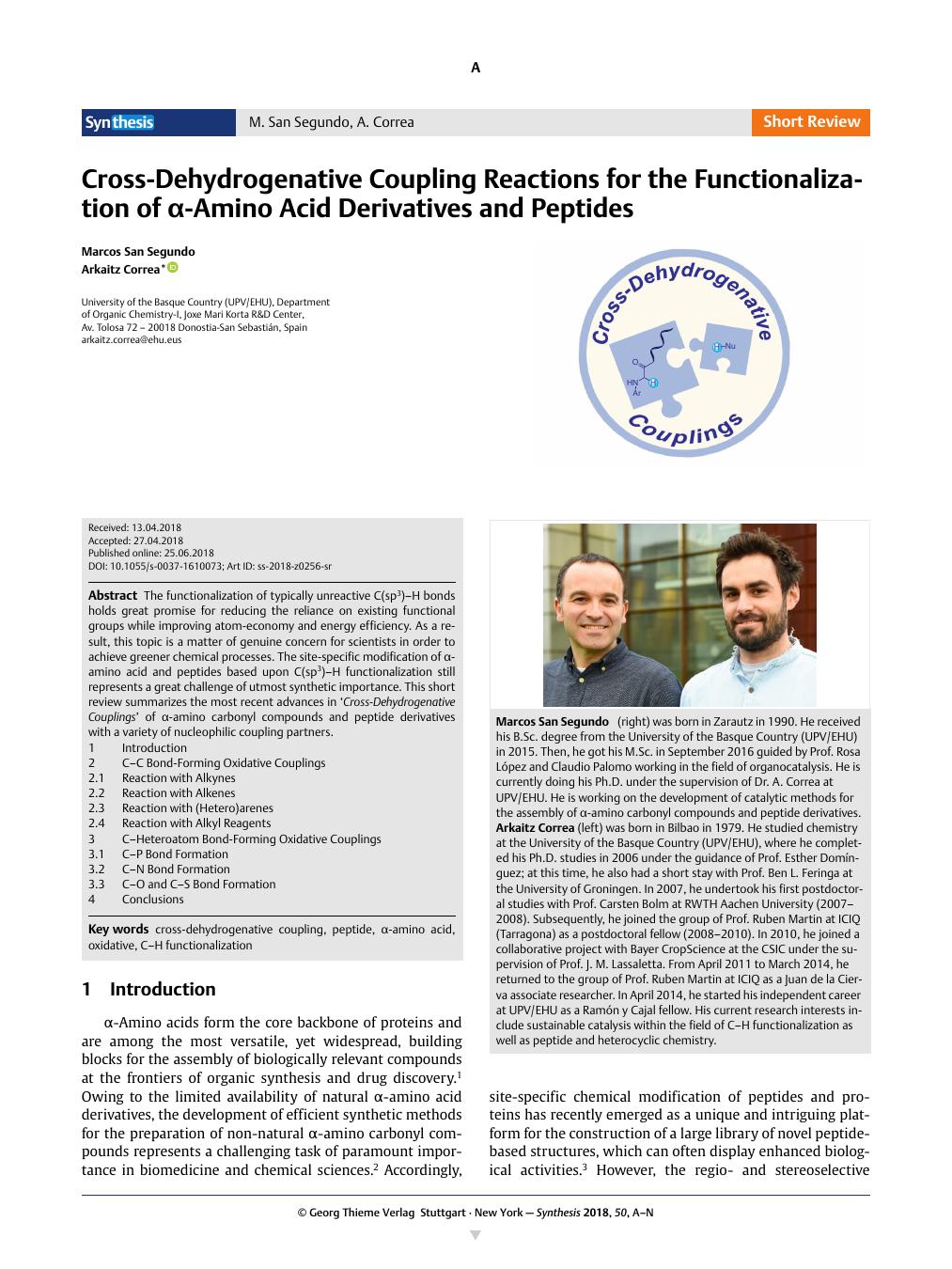Synthesis ( IF 2.2 ) Pub Date : 2018-06-25 , DOI: 10.1055/s-0037-1610073 Arkaitz Correa , Marcos Segundo

|
Abstract
The functionalization of typically unreactive C(sp3)–H bonds holds great promise for reducing the reliance on existing functional groups while improving atom-economy and energy efficiency. As a result, this topic is a matter of genuine concern for scientists in order to achieve greener chemical processes. The site-specific modification of α-amino acid and peptides based upon C(sp3)–H functionalization still represents a great challenge of utmost synthetic importance. This short review summarizes the most recent advances in ‘Cross-Dehydrogenative Couplings’ of α-amino carbonyl compounds and peptide derivatives with a variety of nucleophilic coupling partners.
1 Introduction
2 C–C Bond-Forming Oxidative Couplings
2.1 Reaction with Alkynes
2.2 Reaction with Alkenes
2.3 Reaction with (Hetero)arenes
2.4 Reaction with Alkyl Reagents
3 C–Heteroatom Bond-Forming Oxidative Couplings
3.1 C–P Bond Formation
3.2 C–N Bond Formation
3.3 C–O and C–S Bond Formation
4 Conclusions
The functionalization of typically unreactive C(sp3)–H bonds holds great promise for reducing the reliance on existing functional groups while improving atom-economy and energy efficiency. As a result, this topic is a matter of genuine concern for scientists in order to achieve greener chemical processes. The site-specific modification of α-amino acid and peptides based upon C(sp3)–H functionalization still represents a great challenge of utmost synthetic importance. This short review summarizes the most recent advances in ‘Cross-Dehydrogenative Couplings’ of α-amino carbonyl compounds and peptide derivatives with a variety of nucleophilic coupling partners.
1 Introduction
2 C–C Bond-Forming Oxidative Couplings
2.1 Reaction with Alkynes
2.2 Reaction with Alkenes
2.3 Reaction with (Hetero)arenes
2.4 Reaction with Alkyl Reagents
3 C–Heteroatom Bond-Forming Oxidative Couplings
3.1 C–P Bond Formation
3.2 C–N Bond Formation
3.3 C–O and C–S Bond Formation
4 Conclusions
中文翻译:

交叉脱氢偶联反应用于α-氨基酸衍生物和肽的功能化
摘要
通常不反应的C(sp 3)–H键的功能化为减少对现有官能团的依赖,同时提高原子经济性和能源效率具有广阔的前景。结果,该主题是科学家真正关心的问题,以便实现更绿色的化学过程。基于C(sp 3)–H功能化的α-氨基酸和多肽的位点特异性修饰仍然代表着最大的合成重要性的巨大挑战。这篇简短的综述总结了α-氨基羰基化合物和具有多种亲核偶联伴侣的肽衍生物在“交叉脱氢偶联”中的最新进展。
1引言
2 C–C键形成氧化偶联
2.1与炔烃的反应
2.2与烯烃的反应
2.3与(杂)芳烃的反应
2.4与烷基试剂的反应
3 C–杂原子键形成的氧化偶联
3.1 C–P键形成
3.2碳氮键的形成
3.3 C–O和C–S键的形成
4。结论
通常不反应的C(sp 3)–H键的功能化为减少对现有官能团的依赖,同时提高原子经济性和能源效率具有广阔的前景。结果,该主题是科学家真正关心的问题,以便实现更绿色的化学过程。基于C(sp 3)–H功能化的α-氨基酸和多肽的位点特异性修饰仍然代表着最大的合成重要性的巨大挑战。这篇简短的综述总结了α-氨基羰基化合物和具有多种亲核偶联伴侣的肽衍生物在“交叉脱氢偶联”中的最新进展。
1引言
2 C–C键形成氧化偶联
2.1与炔烃的反应
2.2与烯烃的反应
2.3与(杂)芳烃的反应
2.4与烷基试剂的反应
3 C–杂原子键形成的氧化偶联
3.1 C–P键形成
3.2碳氮键的形成
3.3 C–O和C–S键的形成
4。结论










































 京公网安备 11010802027423号
京公网安备 11010802027423号